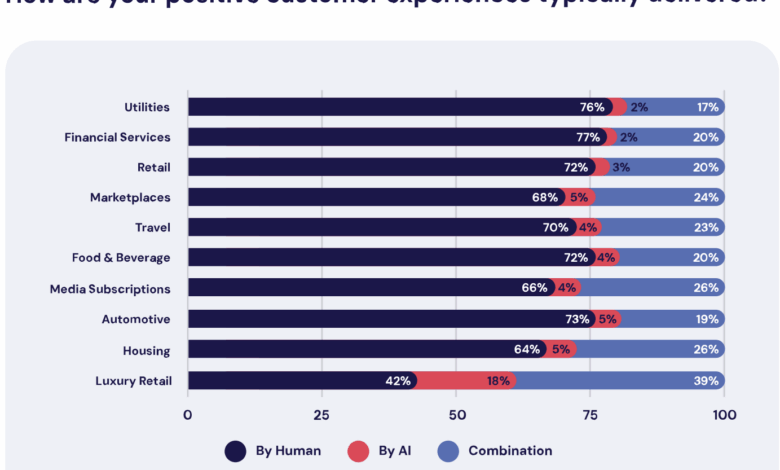
AI adoption in customer service has accelerated in recent years, offering clear efficiency gains in speed, scale and cost. But as automation becomes more deeply embedded into customer support workflows, can it also help businesses win customer loyalty? According to recent research, 76% of positive CX is human-led, driven by the empathy and understanding that customers get from engaging with somebody who understands their challenges.
Customers still need the human connection
Consumers are far from ready to hand over their service interactions entirely to machines. According to Ventrica research, 64% of customers still prefer companies that don’t rely heavily on AI in customer service. While chatbots and self-service tools have their place, the majority of customers (76%) say their most positive service experiences were with a human, not a bot.
This preference isn’t just sentiment; it translates into tangible outcomes. A positive interaction can increase customer spend by up to £199 and directly drive loyalty, with over half of consumers saying they would return to a brand following a positive, human CX. Yet, nearly a third of all customer service interactions are still perceived as negative, and of those, two-thirds of customers say they would stop buying from the brand altogether.
So, how can companies navigate the tension between automation and empathy?
AI as an enabler, not a replacement, for human CX
There is a place for AI, but it should elevate, not replace, the human element in CX, empowering agents with the tools to resolve issues faster, more effectively, and with greater empathy. Too often, automation is used as a blunt instrument, replacing agents rather than supporting them. This approach fails to recognise what customers value: a combination of speed, understanding and genuine human emotion.
AI can handle the repetitive, data-heavy tasks that bog down human agents, freeing them up to focus on the complex, emotionally charged interactions where empathy is most needed. For example, an AI could instantly pull up a customer’s complete purchase history, previous support tickets, and shipping information before an agent even says hello. This eliminates the frustrating need for the customer to repeat their story and allows the agent to dive straight into the solution. This is not about removing the human; it’s about removing the friction. The agent can now use that saved time and information to truly listen, validate the customer’s feelings, and craft a personalised solution that goes beyond a simple script. In this model, the AI acts as a smart assistant, not a replacement for the agent’s core function, which is to connect with and understand the customer on a human level.
Take McDonald’s, where a hybrid approach to customer care has driven 99% resolution rate and a 32% uplift in customer satisfaction. At Clarks, a full omnichannel CX overhaul brought 100% visibility across operations and cut European service costs by 50%. These aren’t outliers; they’re proof that a smart blend of tech and human-CX doesn’t just create better experiences, it delivers measurable business results.
The key is using AI to improve the customer journey with a human, not to replace that connection altogether. AI tools can triage incoming queries more effectively, using natural language processing and historical data to direct customers to the right agent for a faster, more personalised resolution.
Turning complaints into a customer loyalty opportunity
A complaint isn’t a problem – it’s a loyalty opportunity. Resolve it with empathy, and you don’t just save a sale, you strengthen a relationship. The way a brand handles a complaint or issue can often define the entire customer relationship.
The impact of a well-handled complaint can be huge. When a brand representative listens, validates the customer’s frustration, and then swiftly resolves the problem, it creates a sense of being truly heard and valued. This positive emotional response can forge a stronger bond than if the customer had never had an issue at all. It demonstrates that the company stands behind its products or services and genuinely cares about its customers’ satisfaction. This isn’t just about fixing a problem; it’s about rebuilding trust and showing that a relationship matters.
It’s therefore no surprise that when consumers were asked what makes a service experience feel positive, ‘a quick resolution’ was the top factor (chosen by 69%), followed closely by ‘the representative showed empathy and understanding’. It’s this combination – efficient problem-solving and emotional intelligence – that creates truly memorable experiences.
Redesigning the role of AI in customer service
Despite widespread concerns about AI, usage stats suggest that customers are more open to automation than they appear to be, if it’s implemented well. While 82% of customers still prefer to speak on the phone, a significant number also report using email (75%) and chatbots (65%) for support. The issue isn’t AI itself, it’s how it’s used. Too many customers have been burned by clunky, impersonal bots that act as barriers rather than gateways. To avoid this, brands should position AI as a co-pilot – a tool that enhances, not replaces, the agent experience.
AI isn’t the future of CX, emotion is. The brands that thrive won’t just automate, they’ll humanise, combining smart tech with even smarter, empathetic people. By combining the speed and scale of automation with the warmth and intuition of human agents, brands can deliver service experiences that not only resolve issues but also build lasting relationships. In doing so, businesses can shift customer service from a cost centre to a powerful driver of loyalty and revenue.





